2017 NISSAN LEAF navigation
[x] Cancel search: navigationPage 29 of 424
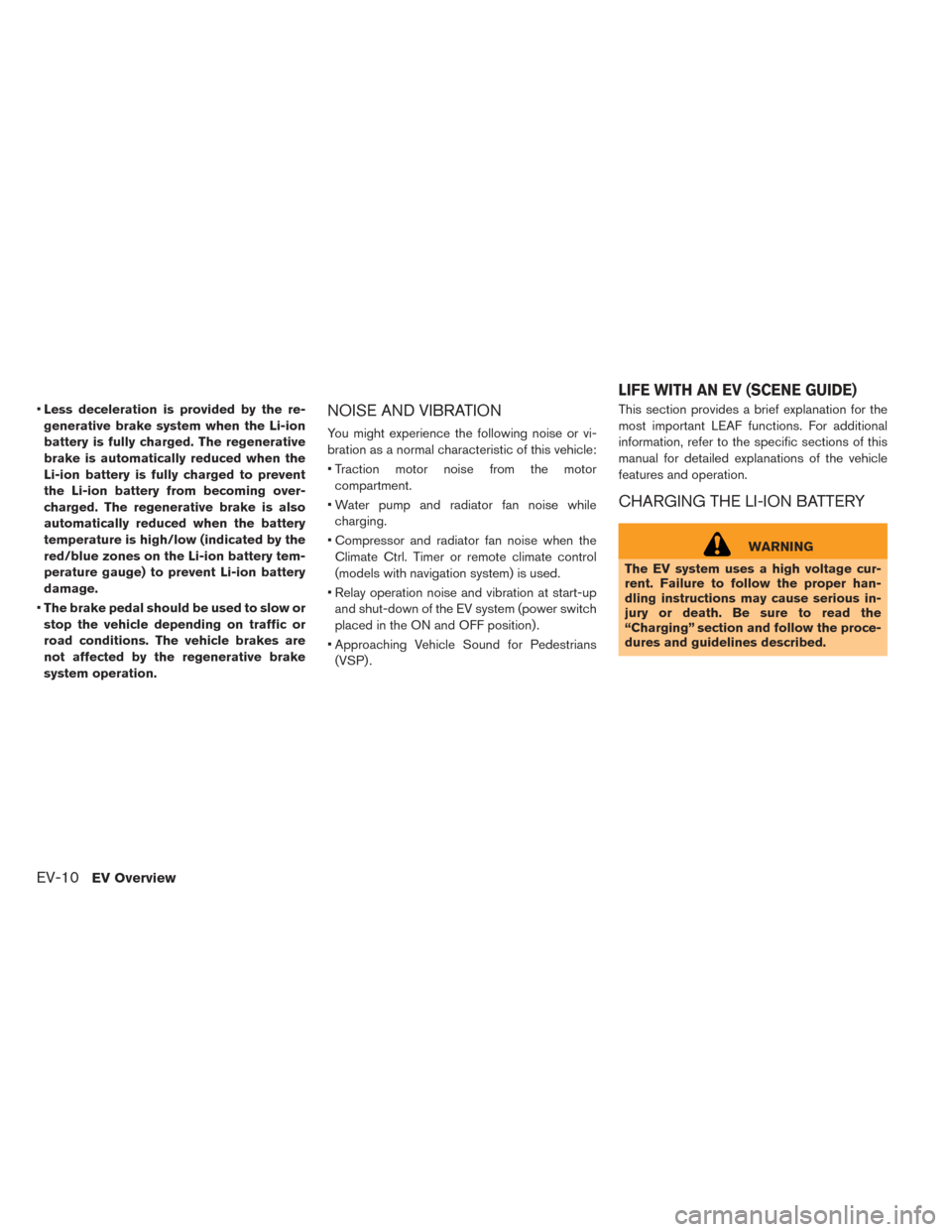
•Less deceleration is provided by the re-
generative brake system when the Li-ion
battery is fully charged. The regenerative
brake is automatically reduced when the
Li-ion battery is fully charged to prevent
the Li-ion battery from becoming over-
charged. The regenerative brake is also
automatically reduced when the battery
temperature is high/low (indicated by the
red/blue zones on the Li-ion battery tem-
perature gauge) to prevent Li-ion battery
damage.
• The brake pedal should be used to slow or
stop the vehicle depending on traffic or
road conditions. The vehicle brakes are
not affected by the regenerative brake
system operation.NOISE AND VIBRATION
You might experience the following noise or vi-
bration as a normal characteristic of this vehicle:
• Traction motor noise from the motor compartment.
• Water pump and radiator fan noise while charging.
• Compressor and radiator fan noise when the Climate Ctrl. Timer or remote climate control
(models with navigation system) is used.
• Relay operation noise and vibration at start-up and shut-down of the EV system (power switch
placed in the ON and OFF position) .
• Approaching Vehicle Sound for Pedestrians (VSP) . This section provides a brief explanation for the
most important LEAF functions. For additional
information, refer to the specific sections of this
manual for detailed explanations of the vehicle
features and operation.
CHARGING THE LI-ION BATTERY
WARNING
The EV system uses a high voltage cur-
rent. Failure to follow the proper han-
dling instructions may cause serious in-
jury or death. Be sure to read the
“Charging” section and follow the proce-
dures and guidelines described.
LIFE WITH AN EV (SCENE GUIDE)
EV-10EV Overview
Page 32 of 424
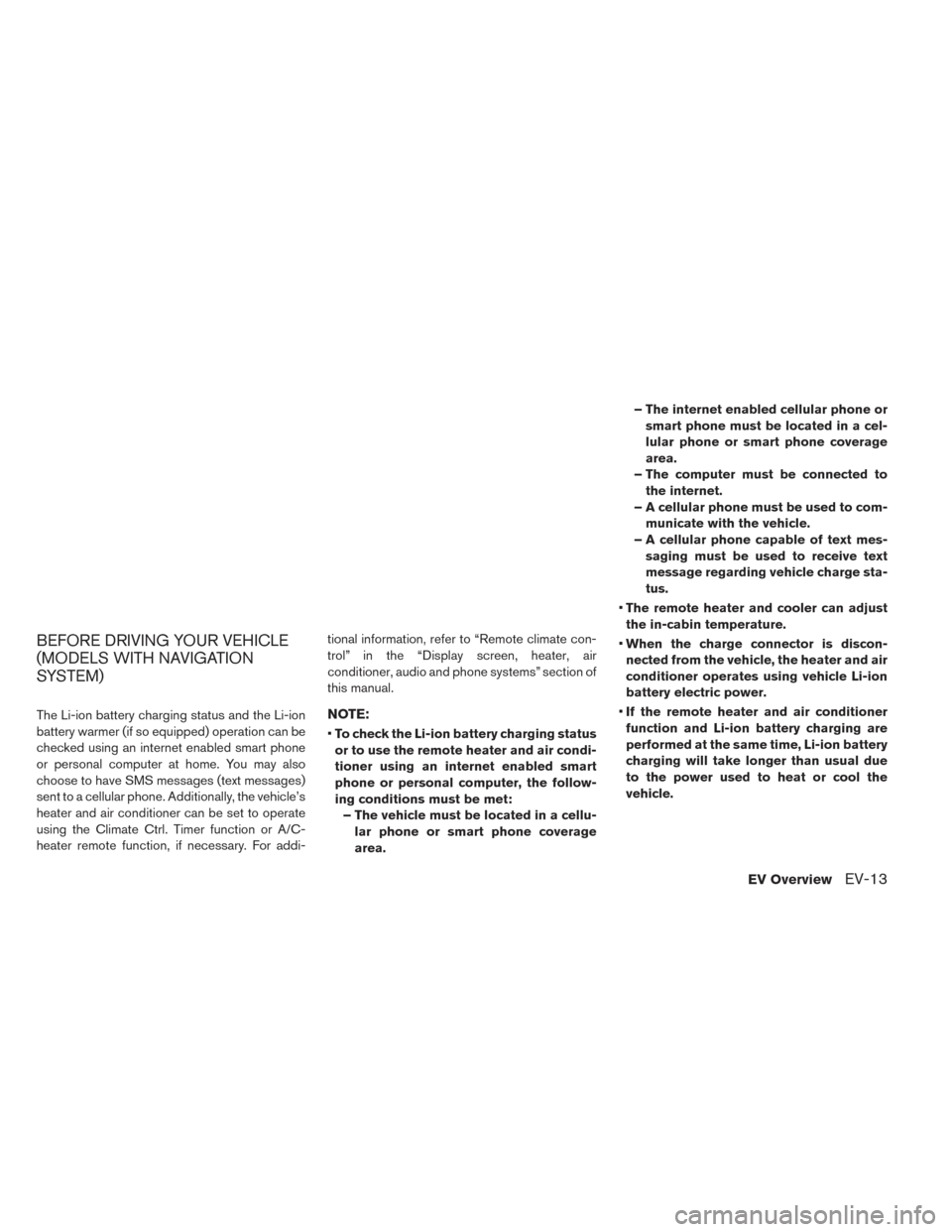
BEFORE DRIVING YOUR VEHICLE
(MODELS WITH NAVIGATION
SYSTEM)
The Li-ion battery charging status and the Li-ion
battery warmer (if so equipped) operation can be
checked using an internet enabled smart phone
or personal computer at home. You may also
choose to have SMS messages (text messages)
sent to a cellular phone. Additionally, the vehicle’s
heater and air conditioner can be set to operate
using the Climate Ctrl. Timer function or A/C-
heater remote function, if necessary. For addi-tional information, refer to “Remote climate con-
trol” in the “Display screen, heater, air
conditioner, audio and phone systems” section of
this manual.NOTE:
•
To check the Li-ion battery charging status
or to use the remote heater and air condi-
tioner using an internet enabled smart
phone or personal computer, the follow-
ing conditions must be met: – The vehicle must be located in a cellu- lar phone or smart phone coverage
area. – The internet enabled cellular phone or
smart phone must be located in a cel-
lular phone or smart phone coverage
area.
– The computer must be connected to the internet.
– A cellular phone must be used to com- municate with the vehicle.
– A cellular phone capable of text mes- saging must be used to receive text
message regarding vehicle charge sta-
tus.
• The remote heater and cooler can adjust
the in-cabin temperature.
• When the charge connector is discon-
nected from the vehicle, the heater and air
conditioner operates using vehicle Li-ion
battery electric power.
• If the remote heater and air conditioner
function and Li-ion battery charging are
performed at the same time, Li-ion battery
charging will take longer than usual due
to the power used to heat or cool the
vehicle.
EV OverviewEV-13
Page 36 of 424
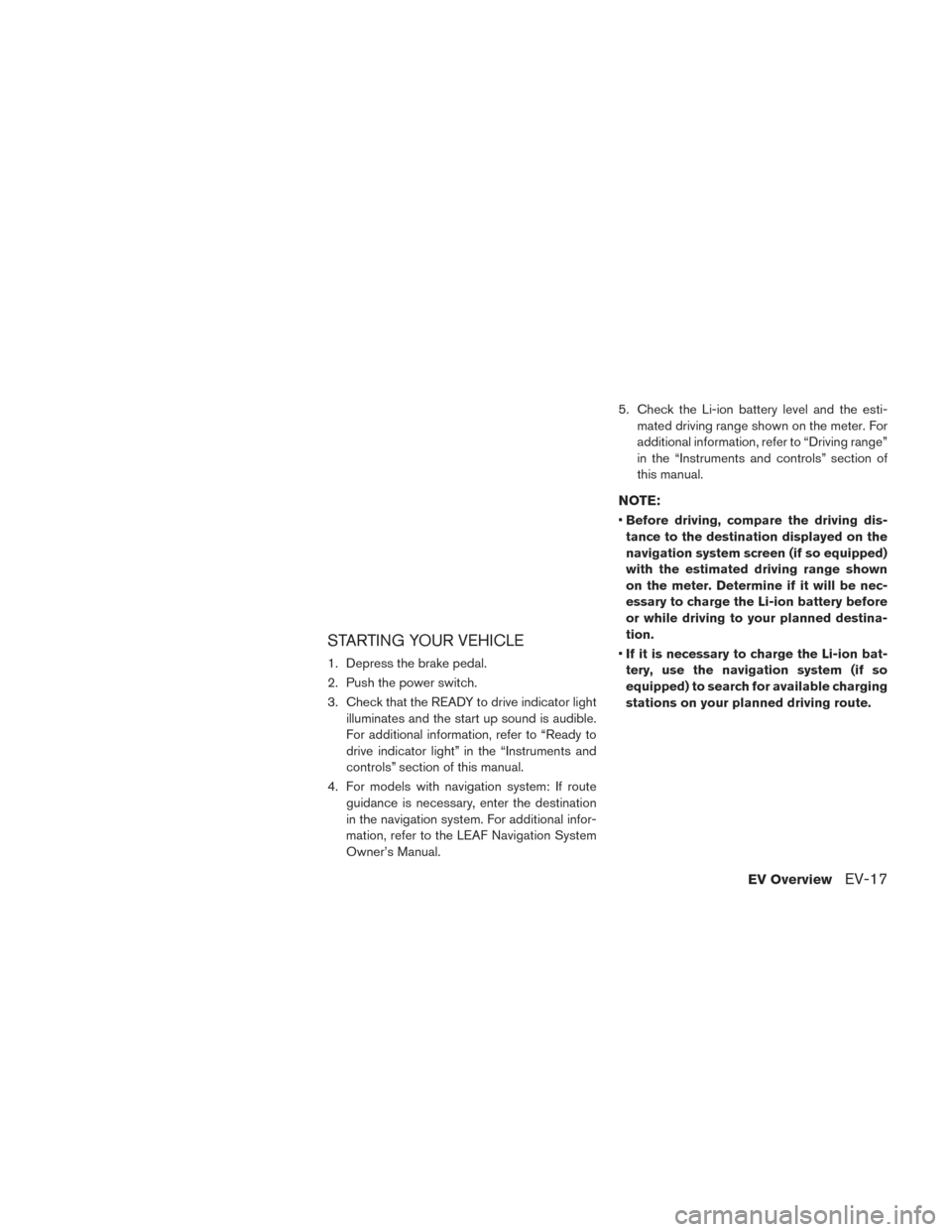
STARTING YOUR VEHICLE
1. Depress the brake pedal.
2. Push the power switch.
3. Check that the READY to drive indicator lightilluminates and the start up sound is audible.
For additional information, refer to “Ready to
drive indicator light” in the “Instruments and
controls” section of this manual.
4. For models with navigation system: If route guidance is necessary, enter the destination
in the navigation system. For additional infor-
mation, refer to the LEAF Navigation System
Owner’s Manual. 5. Check the Li-ion battery level and the esti-
mated driving range shown on the meter. For
additional information, refer to “Driving range”
in the “Instruments and controls” section of
this manual.
NOTE:
•Before driving, compare the driving dis-
tance to the destination displayed on the
navigation system screen (if so equipped)
with the estimated driving range shown
on the meter. Determine if it will be nec-
essary to charge the Li-ion battery before
or while driving to your planned destina-
tion.
• If it is necessary to charge the Li-ion bat-
tery, use the navigation system (if so
equipped) to search for available charging
stations on your planned driving route.
EV OverviewEV-17
Page 41 of 424
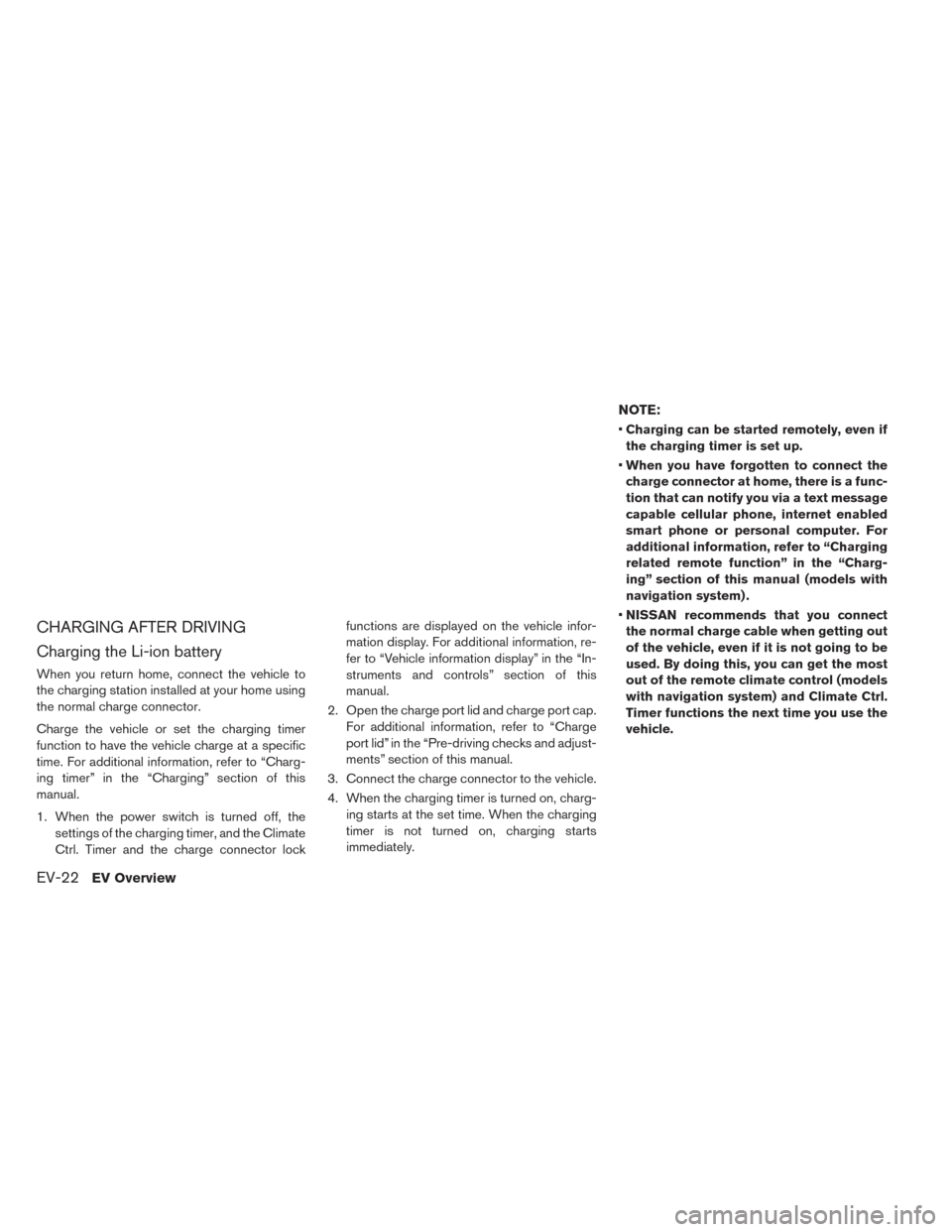
CHARGING AFTER DRIVING
Charging the Li-ion battery
When you return home, connect the vehicle to
the charging station installed at your home using
the normal charge connector.
Charge the vehicle or set the charging timer
function to have the vehicle charge at a specific
time. For additional information, refer to “Charg-
ing timer” in the “Charging” section of this
manual.
1. When the power switch is turned off, thesettings of the charging timer, and the Climate
Ctrl. Timer and the charge connector lock functions are displayed on the vehicle infor-
mation display. For additional information, re-
fer to “Vehicle information display” in the “In-
struments and controls” section of this
manual.
2. Open the charge port lid and charge port cap. For additional information, refer to “Charge
port lid” in the “Pre-driving checks and adjust-
ments” section of this manual.
3. Connect the charge connector to the vehicle.
4. When the charging timer is turned on, charg- ing starts at the set time. When the charging
timer is not turned on, charging starts
immediately.
NOTE:
•Charging can be started remotely, even if
the charging timer is set up.
• When you have forgotten to connect the
charge connector at home, there is a func-
tion that can notify you via a text message
capable cellular phone, internet enabled
smart phone or personal computer. For
additional information, refer to “Charging
related remote function” in the “Charg-
ing” section of this manual (models with
navigation system) .
• NISSAN recommends that you connect
the normal charge cable when getting out
of the vehicle, even if it is not going to be
used. By doing this, you can get the most
out of the remote climate control (models
with navigation system) and Climate Ctrl.
Timer functions the next time you use the
vehicle.
EV-22EV Overview
Page 49 of 424
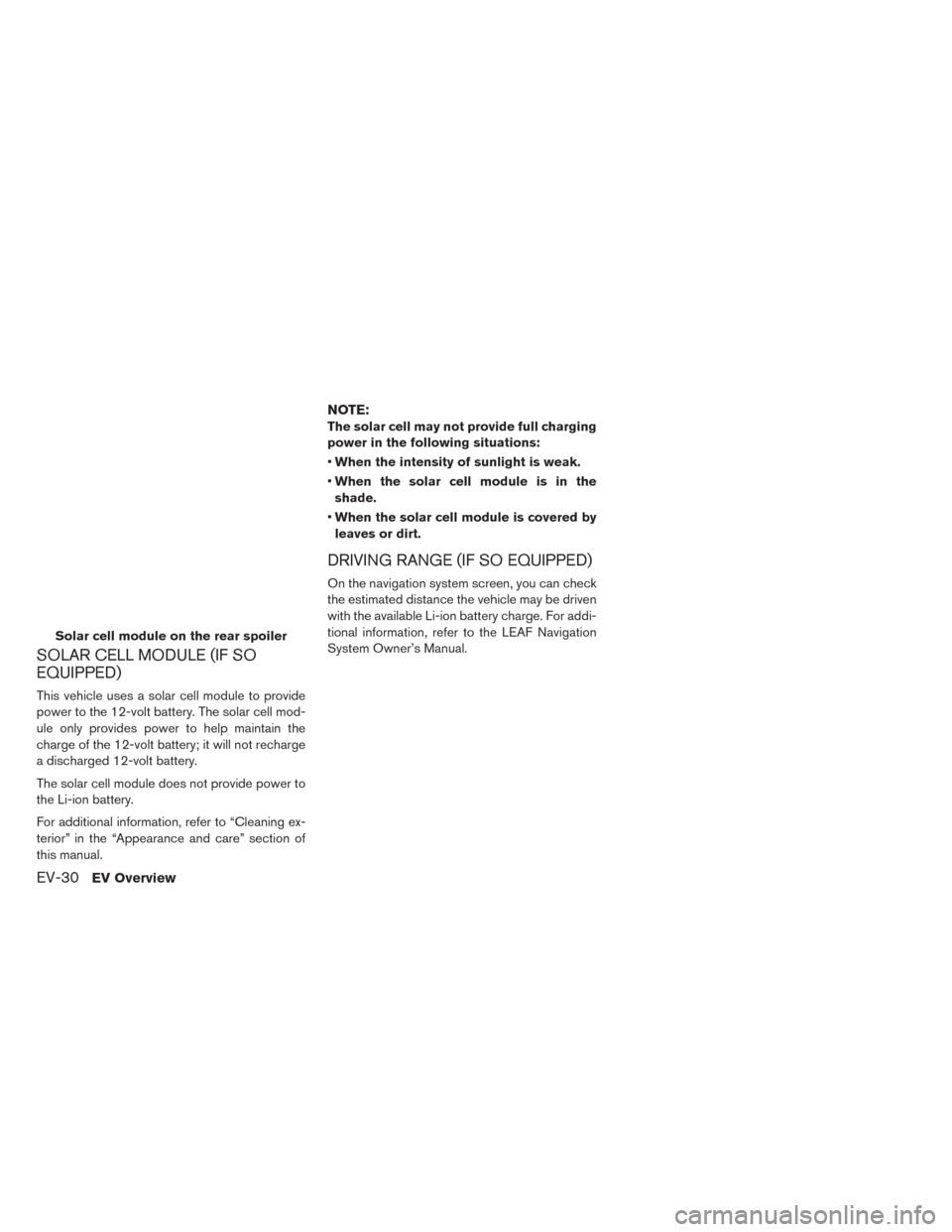
SOLAR CELL MODULE (IF SO
EQUIPPED)
This vehicle uses a solar cell module to provide
power to the 12-volt battery. The solar cell mod-
ule only provides power to help maintain the
charge of the 12-volt battery; it will not recharge
a discharged 12-volt battery.
The solar cell module does not provide power to
the Li-ion battery.
For additional information, refer to “Cleaning ex-
terior” in the “Appearance and care” section of
this manual.
NOTE:
The solar cell may not provide full charging
power in the following situations:
•When the intensity of sunlight is weak.
• When the solar cell module is in the
shade.
• When the solar cell module is covered by
leaves or dirt.
DRIVING RANGE (IF SO EQUIPPED)
On the navigation system screen, you can check
the estimated distance the vehicle may be driven
with the available Li-ion battery charge. For addi-
tional information, refer to the LEAF Navigation
System Owner’s Manual.
Solar cell module on the rear spoiler
EV-30EV Overview
Page 50 of 424
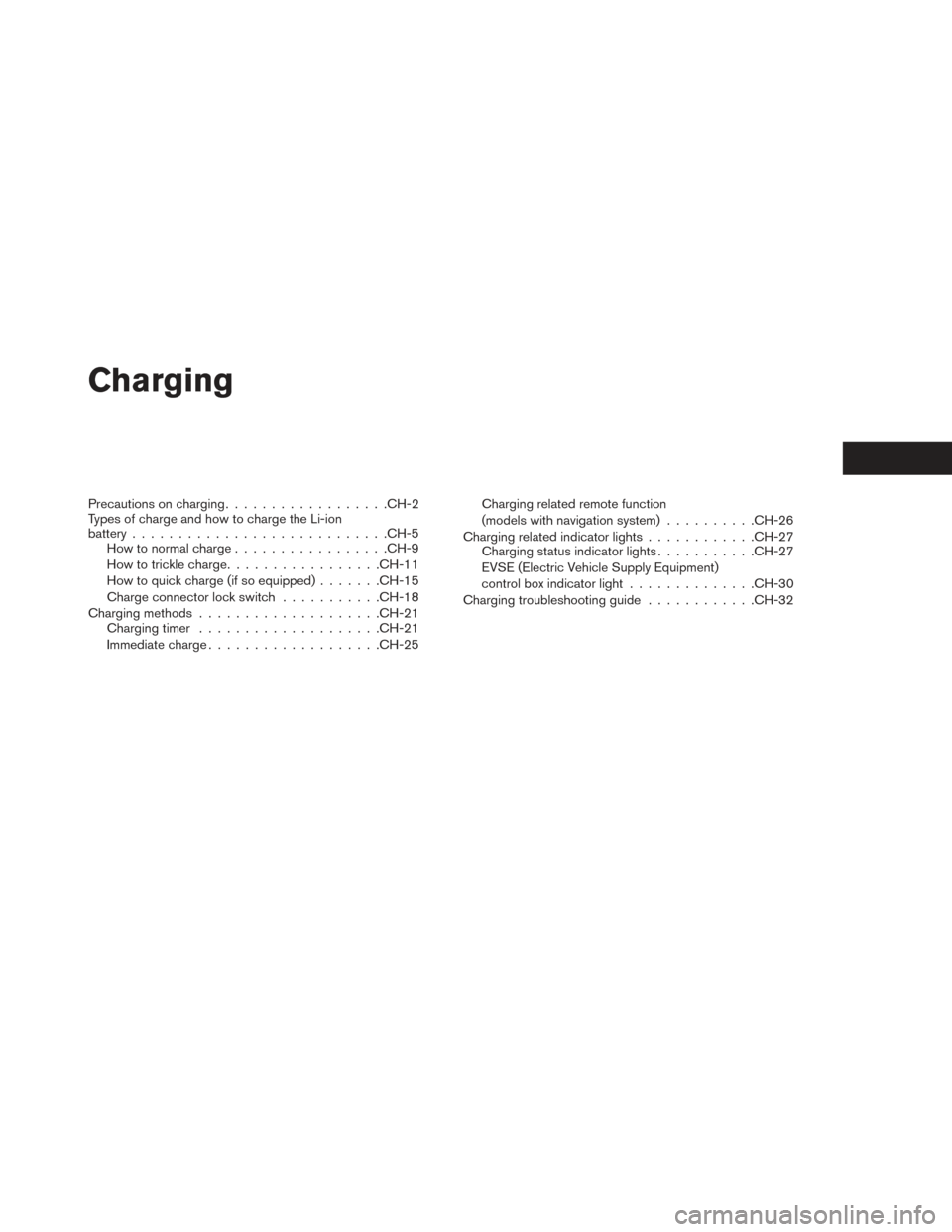
Charging
Precautions on charging................. .CH-2
Types of charge and how to charge the Li-ion
battery ........................... .CH-5
How to normal charge ................ .CH-9
How to trickle charge ................ .CH-11
How to quick charge (if so equipped) .......CH-15
Charge connector lock switch ...........CH-18
Charging methods ................... .CH-21
Charging timer ................... .CH-21
Immediate charge .................. .CH-25Charging related remote function
(models with navigation system)
..........CH-26
Charging related indicator lights ............CH-27
Charging status indicator lights ...........CH-27
EVSE (Electric Vehicle Supply Equipment)
control box indicator light ..............CH-30
Charging troubleshooting guide ............CH-32
Page 53 of 424
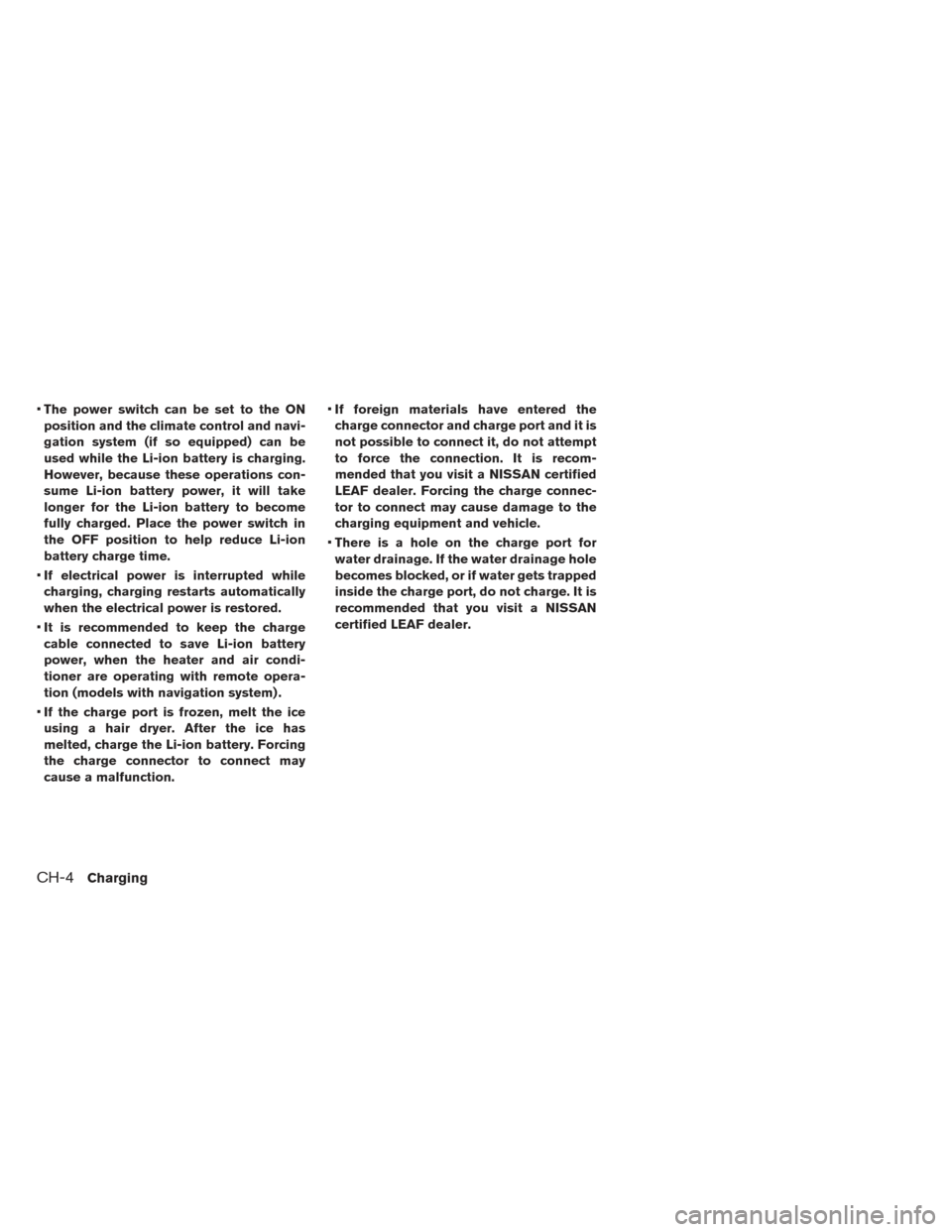
•The power switch can be set to the ON
position and the climate control and navi-
gation system (if so equipped) can be
used while the Li-ion battery is charging.
However, because these operations con-
sume Li-ion battery power, it will take
longer for the Li-ion battery to become
fully charged. Place the power switch in
the OFF position to help reduce Li-ion
battery charge time.
• If electrical power is interrupted while
charging, charging restarts automatically
when the electrical power is restored.
• It is recommended to keep the charge
cable connected to save Li-ion battery
power, when the heater and air condi-
tioner are operating with remote opera-
tion (models with navigation system) .
• If the charge port is frozen, melt the ice
using a hair dryer. After the ice has
melted, charge the Li-ion battery. Forcing
the charge connector to connect may
cause a malfunction. •
If foreign materials have entered the
charge connector and charge port and it is
not possible to connect it, do not attempt
to force the connection. It is recom-
mended that you visit a NISSAN certified
LEAF dealer. Forcing the charge connec-
tor to connect may cause damage to the
charging equipment and vehicle.
• There is a hole on the charge port for
water drainage. If the water drainage hole
becomes blocked, or if water gets trapped
inside the charge port, do not charge. It is
recommended that you visit a NISSAN
certified LEAF dealer.
CH-4Charging
Page 58 of 424
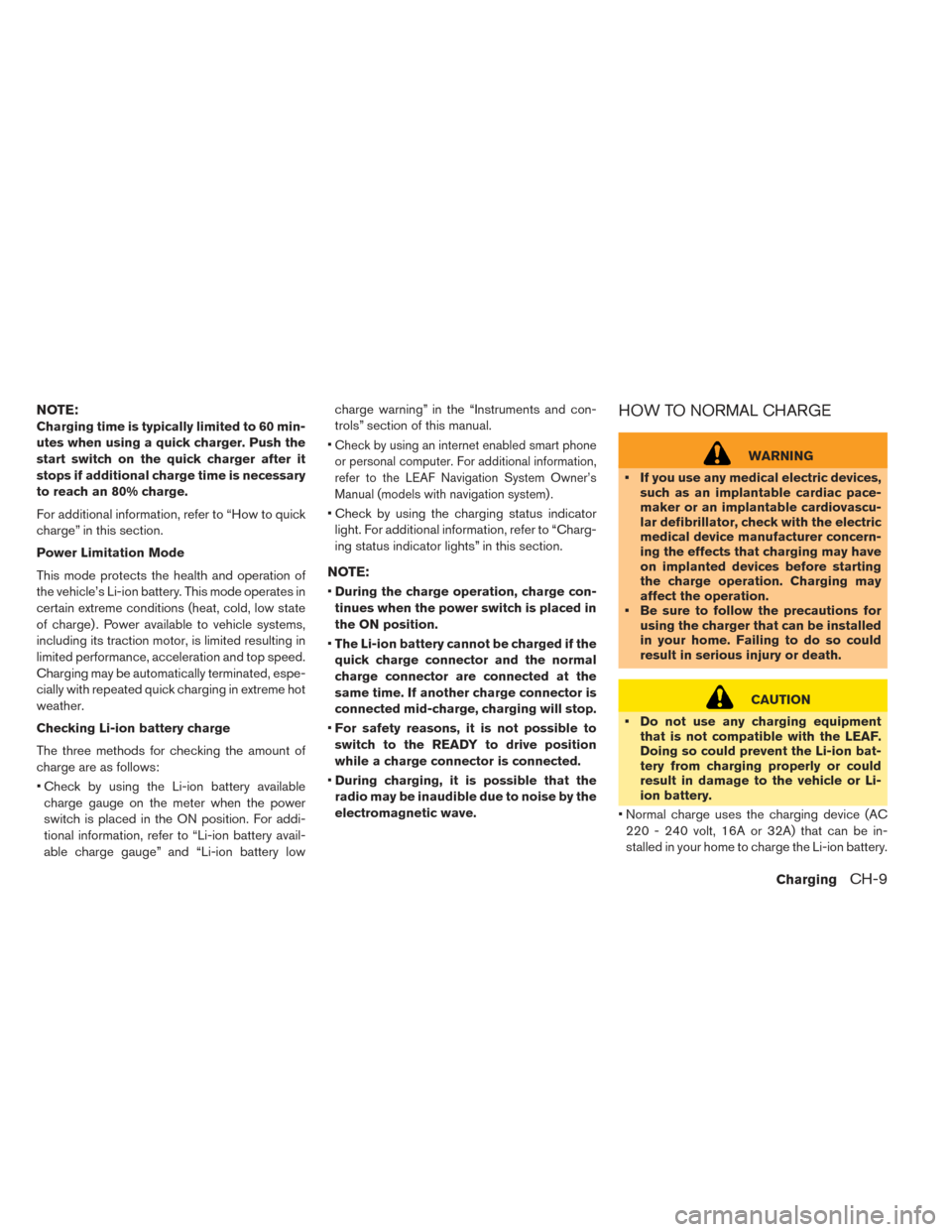
NOTE:
Charging time is typically limited to 60 min-
utes when using a quick charger. Push the
start switch on the quick charger after it
stops if additional charge time is necessary
to reach an 80% charge.
For additional information, refer to “How to quick
charge” in this section.
Power Limitation Mode
This mode protects the health and operation of
the vehicle’s Li-ion battery. This mode operates in
certain extreme conditions (heat, cold, low state
of charge) . Power available to vehicle systems,
including its traction motor, is limited resulting in
limited performance, acceleration and top speed.
Charging may be automatically terminated, espe-
cially with repeated quick charging in extreme hot
weather.
Checking Li-ion battery charge
The three methods for checking the amount of
charge are as follows:
• Check by using the Li-ion battery availablecharge gauge on the meter when the power
switch is placed in the ON position. For addi-
tional information, refer to “Li-ion battery avail-
able charge gauge” and “Li-ion battery low charge warning” in the “Instruments and con-
trols” section of this manual.
•
Check by using an internet enabled smart phone
or personal computer. For additional information,
refer to the LEAF Navigation System Owner’s
Manual (models with navigation system) .
• Check by using the charging status indicator light. For additional information, refer to “Charg-
ing status indicator lights” in this section.
NOTE:
•During the charge operation, charge con-
tinues when the power switch is placed in
the ON position.
• The Li-ion battery cannot be charged if the
quick charge connector and the normal
charge connector are connected at the
same time. If another charge connector is
connected mid-charge, charging will stop.
• For safety reasons, it is not possible to
switch to the READY to drive position
while a charge connector is connected.
• During charging, it is possible that the
radio may be inaudible due to noise by the
electromagnetic wave.
HOW TO NORMAL CHARGE
WARNING
• If you use any medical electric devices, such as an implantable cardiac pace-
maker or an implantable cardiovascu-
lar defibrillator, check with the electric
medical device manufacturer concern-
ing the effects that charging may have
on implanted devices before starting
the charge operation. Charging may
affect the operation.
• Be sure to follow the precautions for using the charger that can be installed
in your home. Failing to do so could
result in serious injury or death.
CAUTION
• Do not use any charging equipment that is not compatible with the LEAF.
Doing so could prevent the Li-ion bat-
tery from charging properly or could
result in damage to the vehicle or Li-
ion battery.
• Normal charge uses the charging device (AC 220 - 240 volt, 16A or 32A) that can be in-
stalled in your home to charge the Li-ion battery.
ChargingCH-9